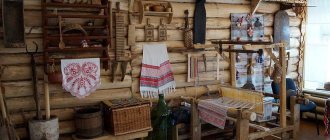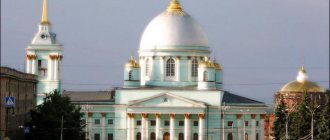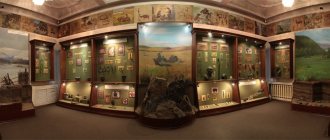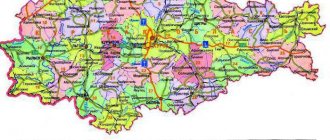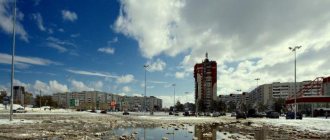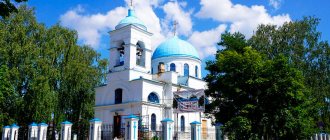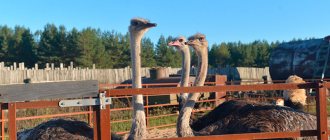On the banks of the Sanokhta River in the Nizhny Novgorod region stands the city of Semenov. It is often proudly called “little Paris”. The settlement received this nickname due to its layout. The town was rebuilt during the time of Catherine II, according to a plan created in the best traditions of French town planning. Semenov was given city status in 1779. Today's Semenov is a city of regional significance with great tourism potential; it is home to a variety of historical, cultural and modern attractions.
What to see in Semenov – TOP-3
The main value for a tourist arriving in Semenov is the main museum center, the painting factory and the pedestrian Lenin Street. We recommend visiting these sights in 1 day of your trip.
Museum-tourist
- Address: st. Chkalova, 18V.
The wooden toy Matryoshka and the famous Khokhloma painting can easily be considered symbols of Russian folk culture. For the city of Semenov, they became a kind of “trick” that determined its tourism potential. It is the city of Semenov that is often called the “homeland” of both nesting dolls and Khokhloma.
Strictly historically, this is not entirely true, but the settlement became an important center for the development of the legendary craft. “Khokhloma painting” settled here almost immediately after the formation of the city - at the end of the 18th century.
A rich local tradition was formed here, the “calling card” of which was the painted Semyonovskaya matryoshka doll, which combined two recognizable images of Russian culture. The museum-tourist has been operating since 2009; many examples of painted Khokhloma products are presented here.
The collection includes examples of painting from the 19th – early 20th centuries. and majestic modern exhibits created in our day. These are spoons, dishes, pieces of furniture and of course nesting dolls of different sizes. The “royal room” is considered the pearl of the exhibition, striking in its splendor. Painting master classes are offered to those interested.
Factory "Semyonovskaya painting"
- Address: st. Chernyshevsky, 1.
The painted traditions of the city are continued by the Semenovskaya Painting factory, founded in Soviet times, in 1932, and still operating successfully. The company went down in history as the site of production of the world's largest nesting doll, which included 72 dolls. The products of Semenovskaya Painting are exported to different parts of the world; from the 1960s to the present day it is considered the largest and most famous in the Nizhny Novgorod region.
Tours are held around the factory, visitors are introduced to the features of production, technology, the main stages of creating a painting, and are told about the history and features of the craft. Products painted with Khokhloma can be purchased in souvenir shops, including at the enterprise and in the museum center. As reviews say, this will be the best memory of visiting the city of Semenov.
Lenin Street
- Address: Lenin street.
One of the central streets of the city has been turned into a pedestrian zone, a walk along which will allow you to feel the historical flavor of the city, the features of the so-called “semantic development” of the Catherine era.
The street is small, only 200 meters, but it is where the brightest architectural and historical sights and the most beautiful buildings of the city are concentrated.
Wooden houses with rich carved decorations have become a recognizable feature of the city’s architectural appearance; they can be found, among other things, on the main pedestrian street, now named after V.I. Lenin.
Population[ | ]
| Population | ||||||||
| 1856[8] | 1897[8] | 1913[8] | 1926[8] | 1931[8] | 1959[9] | 1967[8] | 1970[10] | 1979[11] |
| 2800 | ↗3800 | ↗5100 | ↗6000 | ↗7500 | ↗19 837 | ↗23 000 | ↗23 633 | ↗25 199 |
| 1989[12] | 1992[8] | 2000[8] | 2001[8] | 2002[13] | 2003[8] | 2005[8] | 2006[8] | 2008[14] |
| ↗26 282 | ↗26 600 | →26 600 | ↘26 500 | ↘25 298 | ↗25 300 | ↘25 000 | ↘24 800 | ↘24 433 |
| 2009[14] | 2010[13] | 2011[8] | 2012[15] | 2013[16] | 2014[17] | 2015[18] | 2016[19] | 2017[20] |
| ↘24 351 | ↗24 473 | ↗24 500 | ↘24 433 | ↗24 442 | ↗24 503 | ↘24 451 | ↗24 583 | ↘24 536 |
| 2018[21] | 2019[22] | 2020[1] | ||||||
| ↘24 400 | ↘24 180 | ↘24 067 | ||||||
The main museums of the city of Semenov
When traveling around Semenov, in addition to, other museums are also a must-see - historical, folk, crafts and nesting dolls.
Historical and Art Museum
- Address: st. Vaneeva, 5.
The main museum of the city dates back to 1934; the artist Georgy Matveev is considered its founder. Nowadays, the location of the museum’s exhibition halls is the historical building of the merchant Sharygin’s mansion, built in the 19th century. The historical part tells about the city, its way of life, culture, and famous natives.
“Merchant's Room” will introduce you to the life of townspeople in the pre-revolutionary era. One of the important topics for the history and culture of the city is the Old Believers. One of the museum halls is dedicated to him. Attention is paid to the local literary tradition in the museum; ancient books and editions of works by Semyonovsky writers are presented in the corresponding hall.
The theme of Soviet everyday life is also reflected in the museum. Of greatest interest is the large artistic section, which reveals the traditions of the main city crafts - Khokhloma painting and wood carving. The exhibition features works by local carvers, wooden toys, and, of course, Semyonov nesting dolls.
Museum of Folk Life "House of Semyon the Spooner"
- Address: st. Chkalova, 18/1.
A wooden spoon is an obligatory attribute of Russian life and one of the most popular items for painting under Khokhloma. Since 2013, the “House of Semyon Lozhkar” museum has been operating on the territory of the factory in the city of Semenov.
The name refers to the legend about the spoon maker Semyon, who together with his family was engaged in the production and painting of an indispensable element of kitchen utensils. The museum is not just about spoons. There are a huge number of them here, almost seven hundred varieties, but attention is also paid to the life of the artisan of past centuries. The museum recreates the atmosphere of a wealthy home and displays various everyday items.
There is also an interactive component here, everyone can feel themselves in the role of a peasant artisan, join in the mandatory household activities and try to learn the “Semyonovskaya Quadrille” dance.
Museum of Matryoshka and Traditional Toys
- Address: Chernyshevsky street.
The “main character” of this museum is one of the symbols of the city – the matryoshka doll. It is known that this wooden toy was invented not in Semenov, but in Sergiev Posad. The museum’s exposition tells about the peculiarities of the production and painting of nesting dolls in the production traditions of the two cities, presents the history of the “invention”, the exhibits allow you to trace the evolution of the appearance and “pedigree” of the nesting doll. The museum will also tell you about other traditional children's toys, including rattles, pyramids and much more.
Private Museum of Folk Crafts
- Address: st. Gagarina, 68.
The wooden two-story mansion, built in 1890, once belonged to the third guild merchant Parfen Stroinsky. Nowadays, the building with its remarkable openwork carvings is home to a private museum, which was located here in 2014. Its theme is the craft history of Semenov.
Antique products of shoemakers and blacksmiths, embroidery samples, household items from different eras - all this can be seen in the most interesting exhibition. An educational tour will complement what you see. They say that local guides are able to talk about simple things in a non-trivial way.
Topic: Sights of the Nizhny Novgorod region
"The House of Semyon the Spooner"
The opening of this museum took place in June 2013. It is dedicated to the former life and work of Semenov’s craftsmen, of whom Semyon, the spoon maker, was a prominent representative. According to legend, Semyon, together with his wife and daughter, was engaged in making wooden spoons from birch and maple. These spoons were admired by everyone in the area, and thanks to this skill, Semyon, a spoon maker over a very large area, became famous. The museum hosts master classes and folklore concerts.
Location: Chkalova street - 18.
Churches of Semenov: which temples are worth visiting
Historically, in the religious culture of the city of Semenov, traditional post-reform Orthodoxy coexisted with the Old Believer cult, which was reflected in the sights of the city, becoming its interesting feature.
Old Believer Church of St. Nicholas of Christ
- Address: st. Volodarsky, 12A.
The Old Believer tradition includes the Church of St. Nicholas or St. Nicholas Church. The elegant building in the pseudo-Russian architectural style appeared only at the beginning of the 20th century; the completion date of construction is indicated as 1916.
A single-domed church with a hipped bell tower was erected on the site of a previously existing wooden church dating back to the beginning of the 18th century.
The construction was financed by the merchant Nosov. After opening, the temple did not operate for long. During Soviet times, namely in 1938, the temple was closed. The period of “idleness” lasted 51 years, in 1989 restoration began, the temple returned to religious life.
All Saints Church
- Address: Gagarin street.
The Church of All Saints in Semenov is a brick building belonging to the Russian-Byzantine architectural style. Erected on the site of an old cemetery in 1863. The single-domed temple, built according to the “quadrangle” principle common in temple architecture, has two aisles, connected to a bell tower and a refectory. Topped with an onion dome. After its closure and a period of religious oblivion during the Soviet era, the religious building was used as a water pumping station. Became active again in the 1990s.
Old Believer Monastery New Sharpan
- Coordinates on the map: 56.852496, 44.416107.
Since the 18th century, on the Kerzhenets River there was an Old Believer monastery of Sharpan, the main shrine of which was the icon of the Kazan Mother of God, considered by zealots of the old faith to be Miracle-working. According to legend, she ensured the prosperous existence of the monastery.
In 1849, the icon was taken away by the writer A.I. Melnikov-Pechersky, in the same year the monastery was plundered. After these events, representatives of the community went to the burial place of the nun Fevronia, founding a successor monastery there. The monastery was dubbed “New Sharpan”. The schema-nice led a hermit life, honoring the traditions of their faith.
There is evidence that by 1917 there was only one nun left in the monastery named Dorothea, but officially it existed until 1928. Nowadays, the New Sharpan monastery attracts many tourists interested in history and culture, and for adherents of the Old Believers, the preserved grave of Fevronia remains a place of worship.
Church of the Life-Giving Trinity in Medvedevo
- Address: Semenovsky urban district, Medvedevo village.
In the village of Medvedevo, Semenovsky district, there is a Trinity Church, built in 1925. The modest white stone building with a rounded dome is complemented by a massive and majestic red brick bell tower, which is a striking architectural dominant. The temple was closed during Soviet times. Nowadays, it is again active and belongs to the Nizhny Novgorod diocese of the Russian Orthodox Church.
Holy spring Osinkovsky
- GPS coordinates: 56.738734, 44.307376.
Not far from the village of Osinki, Semenovsky district, a holy spring flows, which is not only a natural, but also a cult and historical object. Once upon a time there was a large and prosperous Old Believer monastery in these places. At the beginning of the 17th century, in the era of Peter the Great, under the threat of ruin, its inhabitants committed a ritual of self-immolation.
On the site of the cells, a well-maintained cemetery has been organized, the graves are marked with crosses. The Osinkovsky well, as it is called in a number of historical documents, is a symbol and mute witness of the Old Believer history of the place. Today it is well maintained; a wooden chapel has been erected over the source.
Monastery New Sharpan
This monastery was founded by Old Believers in the 60s of the 19th century and was their refuge after the burning of the neighboring monastery by supporters of Nikonian reforms. In 1849, the icon of the Kazan Mother of God, proclaimed miraculous by the Old Believers, was removed from the monastery. As a result, the inhabitants of Sharpan moved to a neighboring monastery, which they called New Sharpan. Today it is for women, but even now you can come to it for worship.
Semenovskaya urban architecture
In the city and its surroundings there are a number of interesting architectural sites - estates, mansions and just buildings that are now occupied by government agencies.
Estate G.A. Vitushkina
- Address: st. Lenina, 20.
A well-known city dweller, owner of a spoon production workshop, Grigory Vitushkin, lived in a red-brick two-story mansion, which he built with his own funds at the end of the 19th century.
Standing out for its plastic architectural forms with a richly decorated facade, arched windows and entrance gates, the building has become one of the dominant features in the historical appearance of Lenin Street.
Estate of I. Khanykin
- Address: Lenin street, 5.
An architectural monument of the late 19th century is the building of the city military registration and enlistment office, also located in the pedestrian zone on Lenin Street. The red-painted two-story house with white decorative elements is a typical example of a merchant mansion of its time. It belonged to the manufacturer Ivan Khanykin.
Mansion A.P. Nosova
Adherent of the Old Believers A.P. Nosov, who donated the stone St. Nicholas Church to the city, was a merchant of the second guild, managed to make a name and fortune for himself in the production of spoons. Next to the church, on the street now named after Volodarsky, stands his mansion - a two-story building with a “turret”. The house, built in 1870 and reconstructed at the beginning of the 19th century, is now protected by the state as an architectural monument.
Romanov School
- Address: st. 3 Communists, 31.
In 1913, when the reigning Romanov dynasty celebrated its 300th anniversary, an elementary school was opened in the city of Semenov, located in a specially built building. On the occasion of the anniversary event, the educational institution became known as the Romanov School.
After the revolution, it was transformed into a regular secondary school. Her student was the famous poet Boris Kornilov. Over more than a century of history, the building has been rebuilt several times, while remaining an architectural and historical landmark that has retained in its appearance the “general spirit” of the beginning of the last century.
House with applied carvings
- Address: st. Vaneeva, 14.
The city of Semenov is famous for its wood carving skills; this tradition is reflected in the city architecture. Lace trims and elegant wooden decor with ornaments decorated a residential wooden house on Vaneev Street. The building has a rich history.
The house once belonged to a merchant who sold spoons, later it was a printing house and a meeting place for the “revolutionary cell”, and after the revolution it was given over to housing and still performs this function, being recognized as an object of cultural heritage. For a short time in 1922-1923, the family of Boris Kornilov lived here.
Content
- 1 Geography
- 2 History
- 3 Population
- 4 Heraldry
- 5 Administrative device
- 6 Economics
- 7 Minerals
- 8 Trade and services
- 9 Communications and telecommunications
- 10 Media
- 11 Transport
- 12 Education
- 13 Culture
- 14 Sports
- 15 Sights, museums
- 16 See also
- 17 Notes
- 18 Literature
- 19 Links
Interesting monuments in Semenov
Of course, Semyonov is not without monuments and memorials, where you can go to take memorable photographs.
Monument to Boris Kornilov
- Address: Boris Kornilov Square.
A native of Semenov became famous as a poet and lyricist, fell under the “machine of repression” and was shot at the age of 31, and was rehabilitated in the 50s. On the occasion of the 60th anniversary, which Boris Kornilov could have celebrated in 1967, his memory in his homeland was immortalized with a monument. The sculptural image of the poet was created by the Moscow author Anatoly Bichukov, People's Artist of the RSFSR.
War Memorial
- Address: Semyonov Station street.
Another work by sculptor A. Bichukov can be seen in Semenov on Chernyshevsky Street in Victory Park. A bronze figure of a soldier stands on a marble pedestal reminiscent of the Soviet flag. This is a military memorial dedicated to the memory of Semenovites who died on the fronts of the Great Patriotic War. It was installed in 1985.
Monument to Internationalist Warriors
- Address: Zavodskaya street.
There are monuments to victims of local military conflicts, often called “monuments to internationalist soldiers,” in many Russian cities. In Semenov it is a composition of two black granite steles and a bell. The monument was erected in 2012 on Chernyshevsky Street. Every year on February 15, city residents lay flowers here.
Bust of Vasily Kuznetsov
- Address: Lenin Square.
A diplomat and politician of the Soviet era, twice awarded the title of Hero of Socialist Labor, Vasily Vasilyevich Kuznetsov was born in the Nizhny Novgorod region. The monument to the statesman, erected in Semenov in 1982, is a bronze bust on a granite pedestal. This is the work of famous masters Leonid Kerbel and Sergei Khadzhibaronov.
Monument to Three Communists
- Address: Lenin street.
In 1979, when the city of Semenov celebrated its 200th anniversary, a sculptural composition consisting of three male figures was installed on October Revolution Square. Their prototypes were real people, ordinary workers who were ardent supporters of the Communist Party. History has preserved their surnames: I. Kozlov, A. Delfontsov and N. Zavyalov. In their person, the city paid tribute to all the “fighters for Soviet power” who died in revolutionary fervor.
Monument to V.I. Lenin
- Address: Lenin Square.
The symbol of the socialist era is the monument to V.I. Lenin, installed in the city center on the square of the same name in 1952. The author of the monument is the famous sculptor M.V. Tomsky. The figure of the leader is made of white stone and mounted on a pedestal of polished pink granite.
Tourist information
Semyonov is a seemingly quiet and unremarkable town. The infrastructure here is not developed, there are practically no entertainment centers for youth, teenagers and children - only cultural monuments and folk craft centers are of interest. Tourists rarely stay in the city for a long time - they usually visit it as part of complex excursions around the Nizhny Novgorod region, staying for one night.
There are not very many hotels in Semyonov. The three-star Paris Hotel is located closer to the center - it is very close to attractions, which is why tourists often stay here. A little further away are the hotels “Nimbus” and “Owl”, which have lower prices. The Semenovsky Ark hotel has recently opened with a picturesque garden and terrace. There is also a recreation center with its own beach, “Yagodnaya Derevnya,” which is worth paying attention to for those who want to spend more time in the city.
There are not very many cafes, bars and restaurants in Semyonov. In the center there is an establishment with traditional Russian fast food under the authentic name “Teremok”. The only restaurant in the city, Krezhenets, is located nearby. At the local factory there is an inexpensive cafe “Khokhloma”. For lovers of Japanese cuisine, there is a place with the simple name “Semyonov Sushi”, from where you can order delivery. For those who prefer to cook on their own, you can shop at Magnit or Pyaterochka, or go to a local farmers market with natural products.
There are no large shopping and entertainment centers in the city. A lover of shopping and souvenirs should stop by the shop at the factory, where you can buy the famous Semyonovsky wooden products.
Natural attractions and recreation areas
The most famous places in Semenov where you can get closer to nature are the river and the biosphere reserve. For recreation, there are camp sites here.
Sanokhta River
- Coordinates: 56.779876, 44.488651.
A small river, Sanokhta, flows through the city. Semenovsky urban district is the only municipal entity on the banks of the 29-kilometer artery. In the center of the city the river forms a dam. Sanokhta attracts lovers of water tourism, fishing and recreation by the water.
Recreation center "Berry Village"
- Address: Semenovsky urban district, Merinovo village.
Seven kilometers from Semenov, among picturesque nature, is located the “Berry Village”, a recreation center with its own flavor, where tourists are offered comfortable accommodation in a Russian hut, cottage, mansion or hut. The base has all the conditions for active recreation and sports, and there is a multifunctional gym.
In winter, popular entertainment for this time of year is provided - ice skating, skiing, and cheesecake skiing. You can relax and unwind in a Russian bathhouse. On the territory of the recreation center there is also a place for cultural leisure and contact with local traditions. There is a museum here.
Kerzhensky Biosphere Reserve
- Address: Oktyabrskaya street, 17, Rustai village.
The Kerzhensky integrated biosphere reserve was created in 1993 on the banks of the Kerzhenets River. You can admire the pristine nature of the reserve only with a tour or by prior arrangement with the administration of the reserve, as there are strict restrictions for tourists here. In the village An ecological center of the reserve has been opened in Rustai, where lectures are given and excursions are organized.
A little history
After the schism that occurred in the Russian Orthodox Church, believers who disagreed with the patriarch’s reform fled to the remote Kerzhensky region and formed Old Believer settlements there. Later, in 1779, Catherine the Second ordered that Semenov be given the status of a county town and approved a unique development plan in accordance with the principles of French urban planning. According to this plan, the streets of the city, like rays, converge towards the central square. In Russia, not a single city has such a layout, and in Europe there are only Paris and Vienna. The city harmoniously combines the sophistication of European planning and the original Russian flavor, so Semenov is rightfully awarded the status of an urban planning monument.
Interesting surrounding villages
The villages that are part of the Semenovsky urban settlement conceal a lot of interesting things. Those who are interested in the hidden corners of Russian history and culture should definitely take a look there.
Village Merinovo
- Coordinates: 56.784565, 44.610598.
It is believed that the legendary painted “Semyonovskaya nesting doll” was born in Merinovo. The name of the ancient village, according to one version, comes from the ancient “Meryan settlement” located here. The settlement is known as one of the centers of the Old Believers.
Bydreevka village
- Coordinates: 56.835264, 44.637197.
The settlement with a three-hundred-year history was mentioned in the story “The Reception” by the famous writer V. Korolenko. It became the starting point for the author’s journey along the Kerzhenets River. The main rural attraction is the Church of the Exaltation of the Cross, built in 1828. Local historians were able to establish that a wooden church previously stood in its place, dating back to the beginning of the 18th century.
The village of Sukhobezvodnoye
- Coordinates: 57.028148, 44.845085.
The history of the settlement is inextricably linked with the abbreviation GULAG, tragic for Soviet history. It arose in the 1930s as a logging settlement; the administration of the Uzhensky forced labor camp was located here. Among its prisoners were people of many nationalities, including Finns. In memory of the representatives of this neighboring people who died in the camp, a granite monument was erected on the territory of the village.
Village Kerzhenets
- Coordinates: 56.906546, 44.627917.
The settlement of the same name on one of the surrounding rivers is located on the railway route. Actually, the station is its main highlight. The building, recognized as a monument of urban planning and architecture, is the creation of a famous author - Alexey Shchusev.
Heraldry[ | ]
Historical coat of arms of Semenov (1781)
The first coat of arms of the city of Semenov was approved on August 16, 1781[23].
The coat of arms of the Semenovsky urban district was approved on February 16, 2012.
The coat of arms is a heraldic shield bordered by a red stripe, consisting of two parts: in the upper part - “a scarlet (red) deer walking in a silver field, having horns with six branches and black hooves,” indicating belonging to the Nizhny Novgorod region, on whose territory the city of Semenov is located; in the lower part there is a fire made of logs stacked in a pyramid on a golden field, signifying the great importance of forests and woodworking in the life of the population. The dividing strip between the fields is red with an element of Khokhloma painting in gold, confirming the historical, cultural and economic significance of the folk craft[24].
Transport[ | ]
Old Believer Church in the name of St. Nicholas the Wonderworker City of Semyonov.
October Revolution Square. A monument to three communists who died in 1919 in a battle with counter-revolutionary bandits hiding in the forests near the village of Olenyevo. (1979) The regional highway Nizhny Novgorod - Kirov runs outside the city. There is a railway station on the new direction of the Trans-Siberian line. Electric trains run to Nizhny Novgorod approximately every hour. Travel time is about 1 hour. The fare is 160 rubles. There is one train stop within the city - platform 506 km, connecting the station and the central part of the city with the Zavodskaya Street microdistrict.
Transport within the city is carried out by JSC Semenovsky Autopark and a small number of private carriers. The bus station is located in the railway station building. There are city, suburban and intercity routes.
The traffic situation on the streets is usually free; there may be minor traffic jams only during rush hours in the central part of the city.
Notes[ | ]
- ↑ 123
Population of the Russian Federation by municipalities as of January 1, 2021 (Russian). Date accessed: October 17, 2021. Archived October 17, 2021. - THE USSR. Administrative-territorial division of the union republics on January 1, 1980 / Comp. V. A. Dudarev, N. A. Evseeva. - M.: Izvestia, 1980. - 702 p. — P. 118.
- Law of the Nizhny Novgorod Region dated December 22, 2010 No. 211-Z “On the transformation of municipalities of the Semenovsky municipal district of the Nizhny Novgorod Region”
- Law of the Nizhny Novgorod Region dated December 22, 2010 No. 212-Z “On changing the administrative-territorial division of the Semenovsky District of the Nizhny Novgorod Region and on amending Article 11 of the Law of the Nizhny Novgorod Region “On the administrative-territorial structure of the Nizhny Novgorod Region”” (unspecified)
(inaccessible link) . Access date: April 9, 2013. Archived January 16, 2014. - Kudryavtseva K. G.
Kerzhenets - the promised land // Materials of the round table on the Old Believers - History of the administrative and territorial division of the Nizhny Novgorod province 1917 - 1929. - 1983. - 292 p.
- Administrative - territorial division and authorities of the Nizhny Novgorod Territory - Gorky Region 1929 - 1979. - 1984. - 264 p.
- ↑ 1 2 3 4 5 6 7 8 9 10 11 12 13
People's encyclopedia “My City”.
Semyonov (city) (undefined)
. Retrieved June 17, 2014. Archived June 17, 2014. - All-Union Population Census of 1959. The size of the urban population of the RSFSR, its territorial units, urban settlements and urban areas by gender (Russian). Demoscope Weekly. Access date: September 25, 2013. Archived April 28, 2013.
- All-Union Population Census of 1970 The size of the urban population of the RSFSR, its territorial units, urban settlements and urban areas by gender. (Russian). Demoscope Weekly. Access date: September 25, 2013. Archived April 28, 2013.
- All-Union Population Census of 1979 The size of the urban population of the RSFSR, its territorial units, urban settlements and urban areas by gender. (Russian). Demoscope Weekly. Access date: September 25, 2013. Archived April 28, 2013.
- All-Union population census of 1989. Urban population (undefined)
. Archived from the original on August 22, 2011. - ↑ 1 2
All-Russian population census 2010.
Number and distribution of the population of the Nizhny Novgorod region (unspecified)
. Retrieved July 30, 2014. Archived July 30, 2014. - ↑ 12
Nizhny Novgorod Region. Estimated resident population as of January 1, 2008-2016 - Population of the Russian Federation by municipalities. Table 35. Estimated resident population as of January 1, 2012 (unspecified)
. Retrieved May 31, 2014. Archived May 31, 2014. - Population of the Russian Federation by municipalities as of January 1, 2013. - M.: Federal State Statistics Service Rosstat, 2013. - 528 p. (Table 33. Population of urban districts, municipal districts, urban and rural settlements, urban settlements, rural settlements) (undefined)
. Retrieved November 16, 2013. Archived November 16, 2013. - Table 33. Population of the Russian Federation by municipalities as of January 1, 2014 (unspecified)
. Access date: August 2, 2014. Archived August 2, 2014. - Population of the Russian Federation by municipalities as of January 1, 2015 (unspecified)
. Access date: August 6, 2015. Archived August 6, 2015. - Population of the Russian Federation by municipalities as of January 1, 2021 (Russian) (October 5, 2018). Date accessed: May 15, 2021. Archived May 8, 2021.
- Population of the Russian Federation by municipalities as of January 1, 2021 (Russian) (July 31, 2017). Retrieved July 31, 2021. Archived July 31, 2021.
- Population of the Russian Federation by municipalities as of January 1, 2021 (Russian). Retrieved July 25, 2018. Archived July 26, 2021.
- Population of the Russian Federation by municipalities as of January 1, 2021 (Russian). Date accessed: July 31, 2019. Archived May 2, 2021.
- Coats of arms: Semyonov city and Semyonovsky district
- Coat of arms of the Semyonovsky urban district
- Archbishop George celebrated the Liturgy of the Presanctified Gifts at the All Saints Church in the city of Semenov (photo) (unspecified)
. Nizhny Novgorod and Arzamas diocese (March 5, 2010). Access date: March 14, 2010. - The opening of the “Museum of Matryoshka Dolls and Traditional Toys” took place in Semenov
. Tourist portal of the Nizhny Novgorod region (11/27/2017).
Economics[ | ]
Semenovsky railway station
In Semenov, an artistic craft is developed - Khokhloma painting (since 1916, originated in the village of Khokhloma, Koverninsky district). In 1925, the “Handicraft Artist” artel was created, from 1931 - the “Export” artel, later “Khokhloma Painting” (transformed into a factory in 1960, reorganized into the artistic association of the same name in 1970). Characteristic are wooden turning products painted “to match the background” with a gilded, virtuoso pattern (fancy garden flowers) on a red or black background.
Also in Semyonov, at the Semyonovskaya Painting art factory, the traditional Russian Semyonovskaya matryoshka doll was born in 1922. Semenovskaya matryoshka is distinguished by a yellow-red background and a bright bouquet of flowers on the apron. In 1970, at the Expo 70 exhibition in Tokyo (Japan), a 72-seat nesting doll was presented. To date [ when?
] the art factory exports more than 60% of its products[
significance of the fact?
].
Administrative device[ | ]
Monument to the poet Boris Kornilov
| The section lacks links to sources. Information must be verifiable or it may be deleted. You can edit the article to add links to authoritative sources. This mark was set on April 9, 2014 . |
The city center has a fairly orderly planning structure that developed in pre-revolutionary times. The other microdistricts of the city that currently exist have appeared since the middle of the last century.
Microdistricts:
- Center (often called the City, a historically developed area of the city. Currently, it houses almost all government institutions, many shopping centers. The residential area is represented mainly by private houses and a small number of apartment buildings);
- Dyakovskoe Pole (the most populous microdistrict in terms of number of residents. The residential area is represented mainly by five-story residential buildings. Active development began in the 1990s and continues to this day);
- New construction (the area was built up in the 1950s-1960s, it was then that the name arose. The housing stock is private houses);
- South-Eastern microdistrict (an area actively under construction, which began to be built up at the end of the 20th century. The housing stock is individual houses and cottages);
- Purekh (the area is represented by two main streets, with small streets diverging from them. The housing stock is private houses, with a small number of apartment buildings).
- Microdistrict of Zavodskaya Street (housing stock - low-rise apartment buildings).
All neighborhoods are connected by public bus routes.
Sports[ | ]
| This section is excessively long or contains unimportant details. If you do not agree with this, please show in the text the materiality of the material presented. Otherwise, the section may be deleted. Details may be on the talk page. |
- Sports and recreation center "Arena" (opened on June 6, 2008, there is a football field with artificial turf, classes are held in sections in many sports).
- In 2009, FC Semenov won the Regional Football Cup.
- In 2015, Semenovsky FC “Semar-Service” won the Nizhny Novgorod Region Regional Champions Cup in mini-football.
- In the city of Semyonov, the Thai boxing and kickboxing club “Mankong” is engaged.
Culture[ | ]
District House of Culture
There are several public associations in the city:
- Folklore ensemble "Rodniki" of the Semenovsky District House of Culture. Founded in August 1994. Participant in the TV show “Play Accordion” by Zavolokin in 1995. Laureate of the folklore competition named after. Livanov 1996 in Nizhny Novgorod. Participant in a TV show prepared by Chuyanov on NTV in 1996. Participants of the Russian Folklore Festival in Ipswich (England) in April-May 1997. Ensemble leader: Kuptsov Valery Pavlovich.
- Poetic association "Springs".
Education[ | ]
In Semenov there are four secondary schools, an Orthodox gymnasium named after. St. Apostle and Evangelist Luke, evening school, Lyceum named after. A. S. Pushkin.
State educational institutions of vocational education:
- GBPOU "Semyonovsky Industrial and Art College" (GBOU SPO SIHT).
Branches of higher educational institutions:
- Semenovsky branch of Nizhny Novgorod State University named after. N. I. Lobachevsky

